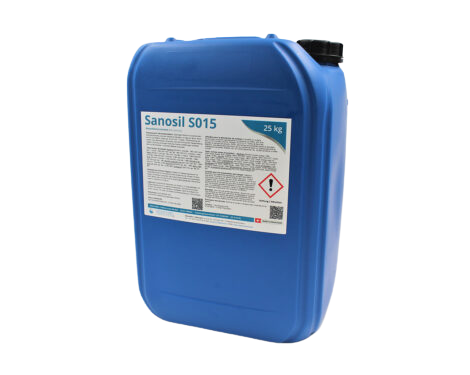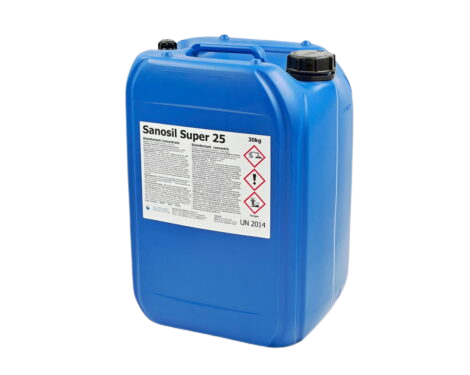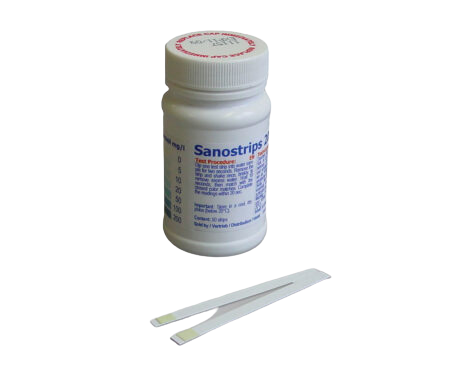[breadcrumb]
Disinfecting chicken coops with a Poultry Disinfectant – when, why and how?
Poultry disinfectant for hygiene in chicken coops is a much-debated topic. How often should the coops be mucked out, cleaned, disinfected with poultry disinfectant products and provided with fresh litter, and what’s the procedure? Does it even make sense to disinfect chicken coops on a regular basis, given that it’s not possible to guarantee sterility anyway? Or is it better to focus on periodic cleaning and disinfestation? Let’s take a look at the details.
Disinfecting chicken coops with a poultry disinfectant – the basics
Poultry disinfectant : when, how and why?
Whereas professional broiler houses contain a rather high number of birds on the minimum square footage prescribed by law and usually empty out after 40 days when the chickens are sent to slaughter, private individuals generally keep chickens out of love for the animals first and to have a self-sufficient supply of eggs and meat second.
[expander_maker id=”2″ more=”Read more” less=”Read less”]It goes without saying that these two ‘modes of operation’ impose different requirements on cleaning and disinfecting chicken coops with poultry farm hygiene products and thus are inherently different.
A professionally built chicken coop tends to forgo wooden parts with many grooves in favour of materials that are smooth, washable and easy to clean, such as concrete, synthetic resin, plastics and chrome steel. This reduces the risk of pests such as mites and lice. However, unlike chicken coops that are used as a hobby, a high number of animals automatically means higher infection pressure. Thus one can conclude that disinfection makes more sense for large commercial chicken sheds. By contrast, more attention should be given to containing parasites in small chicken coops.
Disinfecting chicken coops – drinking trough systems
Drinking trough systems are a very high-risk source of pathogens in chicken coops. Long pipes, suitable temperatures and possibly also deposits in the pipes left by medication or vitamins all promote biofilm growth.
Biofilms are slimy structures that protect microbes within the drinking system from superficial cleaning and poultry farm disinfection. Biofilms cannot be removed by simple flushing and can even resist prevalent disinfectants like chlorine (unless the concentration is very high).
Suitable poultry disinfectant products such as Sanosil S015 or poultry disinfectant Super 25, on the other hand, can break up these structures and detach the film. Regular shock disinfection is therefore highly recommended. Adding a small quantity of disinfectant to the water between shock disinfection cycles effectively prevents such biofilms from forming again.
Chicken coop hygiene – cleaning and disinfecting surfaces with poultry disinfectant
Irrespective of the size, the hygiene procedures around a disinfectant for poultry house for private chicken coops and professional broiler houses are very similar.
One of the most important points is to regularly replace all of the litter. This should occur at least once a month or between life cycles.
First off, all equipment like drinking troughs and feeders should be removed, taken apart and washed thoroughly. Next, the used litter and droppings should be disposed of. Where possible, all washable surfaces should be cleaned thoroughly with soap suds and/or high pressure. Once cleaned, the surfaces need disinfecting with a poultry disinfectant.
Ideally, a liquid disinfectant for poultry is sprayed onto all surfaces, saturating them. This ensures the disinfectant will penetrate all grooves, pores and any deposits of dried chicken droppings. The method is more labour-intensive than using aerosols or foggers, but also guarantees the highest degree of disinfection. We recommend a solution consisting of the disinfectant concentrate Sanosil S015 or, for larger surfaces, Sanosil Super 25. Once the disinfectant has dried, fresh litter can be provided.
Combating pests in chicken coops
Detergents and disinfectants are effective against dirt and bacteria, but sadly not against mites, fleas, lice, mallophaga and other blood-sucking parasites. However, regular cleaning does reduce the numbers of these parasites because they spend most of their time hidden in cracks on the floor and walls of the chicken coop, emerging only to feed on the birds.
By dusting their refuges with siliceous agents such as kieselguhr or amorphous diatomaceous earth, it is possible to combat the mites (wear a respirator). Products containing pyrethrum have also proven effective acaricides for selectively combating mites in chicken coops, as has scorching with a blowtorch.
Both methods should only be applied to coops that have been emptied and cleaned first. In no case should the chickens be dusted or otherwise treated directly. It is possible to add a little kieselguhr to the dust or sand bath, enabling the birds to treat themselves in the appropriate manner.
Special case: combating coccidia and/or worms in chicken coops
There are other pests apart from mites which can attack chickens – for example, coccidia and worms, such as roundworms and lungworms. Both damage the digestive tract and cause red droppings, emaciation/wasting, scruffy feathers and make the birds susceptible to other diseases.
Worm infestations are best dealt with by treating the entire stock, e.g. by administering anthelmintics via the drinking water. It may be necessary to repeat the treatment. Worm eggs may still reside on the surfaces, so in such cases it is worth carrying out a special treatment on the chicken coops as well.
Coccidia are protozoons and, like worms and their eggs, are resistant to virtually all prevalent disinfectants. The only effective products are chlorocresol-based, like Neopredisan. Although disinfectants of this type are effective, they are highly toxic and can also be carcinogenic if used improperly. The manufacturer’s instructions and recommended dose must be strictly observed. Additionally, these products should only be used when an incident occurs and not preventatively.
Chicken coop hygiene – methods and measures when coops are in use
A few final methods can do much to improve chicken coop hygiene and help give the animals an optimal quality of life:
Appropriate litter for chickens should be clean, hygroscopic and, above all, suitable for them to scratch around in. The litter can consist of wood chips, chopped (or pelleted) straw or hemp, an area with sand (for a dust bath) and, as an insider’s tip, dried walnut tree leaves. Admittedly, the latter are better suited for chicken coops kept by hobbyists. But the essential oils they contain are purported to reduce germs and bind odours.
Poultry drinking water treatment: adding a small quantity of a suitable poultry disinfectant to the drinking water (e.g. Sanosil S015 or poultry water disinfectant Super 25 – both using hydrogen peroxide in poultry drinking water disinfection) keeps it free from germs and deposits. Periodically shock-disinfecting and flushing the system is another option. The drinking water can be acidified to prevent bacterial growth from re-establishing itself too quickly, e.g. with vinegar or citric acid.
Combating flies, mice and other pests which bring diseases into the chicken coops: traps and poison are obvious choices to control pests, however care should be taken not to harm the chickens in the process. [/expander_maker]



